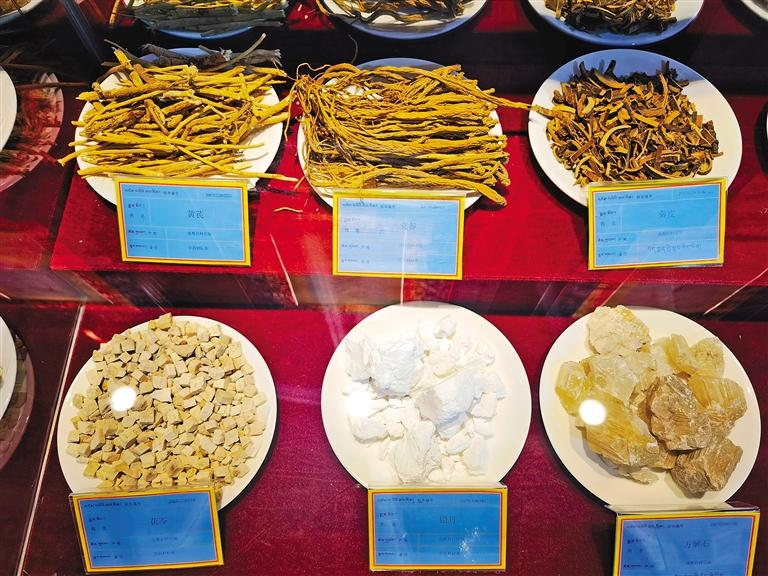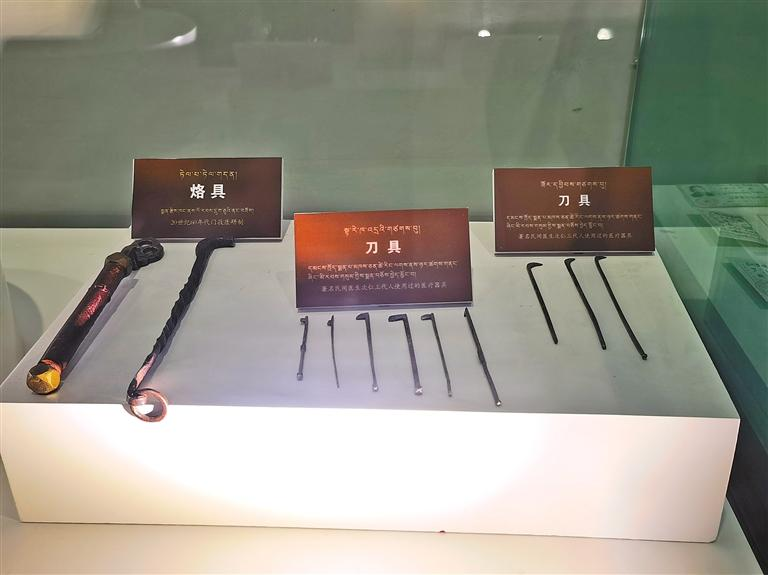Source:xzxw.com 2024-12-13
Tibetan medicine is an integral part of traditional Chinese medicine, and a treasure of Tibetan culture. With the time-honoured history, rich literature, and its own medical system, Tibetan medicine has made significant contributions to the health of local people for thousands of years.

Photo shows a local resident learning about the development and inheritance of Tibetan medicine in the exhibition hall.
In the exhibition hall of Xizang Medicine Hospital at southwest China's Xizang Autonomous Region, the displayed "Mantang"paintings, which are ingeniously conceived, extensive in content and exquisitely crafted, vividly show the Tibetan medical knowledge in the unique Tibetan thangka art form.

Photo shows a large stone basin for grinding medicine designed and madeby Gongga Phuntsog in 1952, a medical master in Menzikang (predecessor of Xizang Medicine Hospital).
Thangka painting is one of the most distinctive and representative art forms in Tibetan culture, and the one specifically represents the Tibetan medical content is called "Mantang" in Tibetan. "Man" refers to medicine and "Tang" refers to thangka. As the most distinctive teaching tool in the inheritance of Tibetan medicine, "Mantang" combines medical knowledge and traditional thangka art form, making a pictorial annotation of Tibetan medical theories and practices. Covering all aspects of Tibetan medical knowledge, and systematically presenting the profoundness of Tibetan medicine, it is a valuable cultural heritage of Chinese nation.

Photo shows the natural herbs and minerals used in Tibetan medicine.
"Mantang" has a history of more than 400 years. The 80 pieces of colored "Mantang" painting of "the Four Medical Treatises" is a collection of the essence of Tibetan medicine, not only displaying the entire extensive content of Tibetan medicine in a colorful visual form, but also reflecting the development and great practice of Tibetan medicine from the establishment of the basic theories, human physiology and pathology, diagnosis, treatment, etiology, symptoms and classification.

Photo shows the items used by Khenrab Norbu, the first director of Menzikang (predecessor of Xizang Medicine Hospital).
In addition, Tibetan medicine is adept at using local medicinal materials, most of which are natural in plateau areas. With unique pharmacological properties and safety, Tibetan medicine stands out in the field of medicine.

Photo shows the medical equipment used in traditional Tibetan medicine.

Photo shows the external treatment equipment used in Tibetan medicine.
In the exhibition hall, all kinds of Tibetan medicinal materials are neatly arranged,and each one carries the Tibetan medical doctors' reverence for nature. These medicinal materials are diverse in form, and unique in efficacy as well, making them valuable resources for the Xizang Medicine Hospital in treating diseases and maintaining health.

Photo shows a few finished products of Tibetan medicine and some raw materials.

Photo shows the plant specimens of Tibetan medicine.
In recent years, Xizang Medicine Hospital has actively implemented the Traditional Chinese Medicine Law, achieving significant results in cultural inheritance and protection, construction of talent teams, scientific research on Tibetan medicine, standardization building, etc.

Photo shows Tibetan calender mathematics books displayed in the exhibition hall of Xizang Medicine Hospital.
To promote the inheritance and development of Tibetan medicine, China continues to increase the investment in Tibetan medical education, encouraging young people to learn and inherit this precious medical heritage. As the only higher education institution in the country specifically established for Tibetan medicine, Xizang University of Tibetan Medicine has trained more than 3,000 professionals over the past 35 years since its establishment. Besides, the university has continuously optimized its professional discipline structure and curriculum system. Currently, there are more than 2,600 students enrolled, and it is expected that in the next five years, the number will reach 3,000, including 500 master's and doctoral students.
Reporter: Liu Linlin, Liu Siyu
Translator: Tenzin Seldron, Zhi Xinghua
Review: Hu Rongguo, Drakpa Wangchen
Copyright © Xizang Daily & China Xizang News All rights reserved
Reproduction in whole or in part without permissions prohibited
Index Code: 藏 ICP 备 05000021 号
Producer: Xizang Daily International Communication Center